Growth of Zn1−xNixO Thin Films and Their Structural, Optical and Magneto-Optical Properties
Abstract
1. Introduction
2. Experimental Section
3. Results and Discussion
4. Conclusions
Author Contributions
Funding
Institutional Review Board Statement
Informed Consent Statement
Data Availability Statement
Acknowledgments
Conflicts of Interest
References
- Dietl, T.; Ohno, H.; Matsukura, M.; Cibert, J.; Ferrand, D. Zener model description of ferromagnetism in zinc-blende magnetic semiconductors. Science 2000, 287, 1019–1022. [Google Scholar] [CrossRef]
- Sato, K.; Katayama-Yoshida, H. Ferromagnetism in a transition metal atom doped ZnO. Phys. E 2001, 10, 251–255. [Google Scholar] [CrossRef]
- Sharma, P.; Gupta, A.; Owens, F.J.; Inoue, A.; Rao, K.V. Room temperature spintronic material—Mn-doped ZnO revisited. J. Magn. Magn. Mater. 2004, 282, 115–121. [Google Scholar] [CrossRef]
- Kim, Y.M.; Yoon, M.; Park, I.-W.; Lyou, J.H. Synthesis and magnetic properties of Zn1−xMnxO films prepared by the sol–gel method. Solid State Commun. 2004, 129, 175–178. [Google Scholar] [CrossRef]
- Diaconu, M.; Schmidt, H.; Hochmuth, H.; Lorenz, M.; Benndorf, G.; Lenzner, J.; Spemann, D.; Setzer, A.; Nielsen, K.-W.; Esquinazi, P.; et al. UV optical properties of ferromagnetic Mn-doped ZnO thin films grown by PLD. Thin Solid Films 2005, 486, 117–121. [Google Scholar] [CrossRef]
- Joseph, D.P.; Kumar, G.S.; Venkateswaran, C. Structural, magnetic and optical studies of Zn 0.95 Mn 0.05 O DMS. Mater. Lett. 2005, 59, 2720–2724. [Google Scholar] [CrossRef]
- Liu, C.; Xiao, B.; Yun, F.; Lee, H.; Ozgur, U.; Moon, Y.T.; Morkoc, H.; Abouzaid, M.; Ruterana, P. Effect of N doping on magnetic properties of (Zn, Mn)O thin films deposited by radio frequency magnetron sputtering. Superlattices Microstruct. 2006, 39, 124–129. [Google Scholar] [CrossRef]
- Assadi, M.H.N.; Zhang, Y.B.; Li, S. N codoping induced ferromagnetism in ZnO: Co (10 1¯ 0) thin films. J. Appl. Phys. 2009, 106, 093911. [Google Scholar] [CrossRef]
- Yang, S.; Man, B.Y.; Liu, M.; Chen, C.S.; Gao, X.G.; Wang, C.C.; Hu, B. Structural, optical and magnetic properties of Zn1−xCoxO dilute magnetic semiconductors thin films by pulsed laser deposition. Phys. B 2010, 405, 4027–4031. [Google Scholar] [CrossRef]
- Fukumura, T.; Jin, Z.; Kawasaki, M.; Shono, T.; Hasegava, T.; Koshihara, S.; Koinuma, H. Magnetic properties of Mn-doped ZnO. Appl. Phys. Lett. 2001, 78, 958–960. [Google Scholar] [CrossRef]
- Ueda, K.; Tabata, H.; Kavai, T. Magnetic and electric properties of transition-metal-doped ZnO films. Appl. Phys. Lett. 2001, 79, 988–990. [Google Scholar] [CrossRef]
- Kane, M.H.; Shalini, K.; Summers, C.J.; Varatharajan, R.; Nause, J.; Vestal, C.R.; Zhang, Z.J.; Ferguson, I.T. Electro-optical effect in ZnO:Mn thin films prepared by Xe sputtering. J. Appl. Phys. 2005, 97, 023906. [Google Scholar] [CrossRef]
- Alaria, J.; Turek, P.; Bernard, M.; Bouloudenine, M.; Berbadj, A.; Brihi, N.; Schmerber, G.; Colis, S.; Dinia, A. No ferromagnetism in Mn doped ZnO semiconductors. Chem. Phys. Lett. 2005, 415, 337–341. [Google Scholar] [CrossRef]
- Wakano, T.; Fujimura, N.; Morinaga, Y.; Abe, N.; Ito, T. Magnetic and magneto-transport properties of ZnO: Ni films. Phys. E 2001, 10, 260–264. [Google Scholar] [CrossRef]
- Basri, S.H.; Abd Majid, W.H.; Talik, N.A.; Mohd Sarjidan, M.A. Tailoring electronics structure, electrical and magnetic properties of synthesized transition metal (Ni)-doped ZnO thin film. J. Alloys Compd. 2018, 769, 640–648. [Google Scholar] [CrossRef]
- Anbuselvan, D.; Nilavazhagan, S.; Santhanam, A.; Chidhambaram, N.; Gunavathy, K.V.; Ahamad, T.; Alshehri, S.M. Room temperature ferromagnetic behavior of nickel-doped zinc oxide dilute magnetic semiconductor for spintronics applications. Phys. E 2021, 129, 114665–114668. [Google Scholar] [CrossRef]
- Liu, E.; Xiao, P.; Chen, J.S.; Lim, B.C.; Li, L. Ni doped ZnO thin films for diluted magnetic semiconductor materials. Curr. Appl. Phys. 2008, 8, 408–411. [Google Scholar] [CrossRef]
- Yin, Z.G.; Chen, N.; Yang, F.; Song, S.L.; Chai, C.L.; Zhang, J.; Qian, H.J.; Ibrahim, K. Structural, magnetic properties and photoemission study of Ni-doped ZnO. Solid State Commun. 2005, 135, 430–433. [Google Scholar] [CrossRef]
- Savchuk, A.I.; Gorley, P.N.; Khomyak, V.V.; Ulyanytsky, K.S.; Bilichuk, S.V.; Perrone, A.; Nikitin, P.I. ZnO-based semimagnetic semiconductors: Growth and magnetism aspects. Mater. Sci. Engine B 2004, 109, 196–199. [Google Scholar] [CrossRef]
- Savchuk, A.I.; Fediv, V.I.; Savchuk, S.A.; Perrone, A. Growth and characterization of ZnMnO thin films. Superlattices Microstruct. 2005, 38, 421–427. [Google Scholar] [CrossRef]
- Savchuk, A.I.; Fediv, V.I.; Kleto, G.I.; Krychun, S.V.; Savchuk, S.A. Optical and magneto-optical properties of ZnMnO and ZnMnFeO single crystals and thin films. Phys. Status Solidi A 2007, 204, 106–111. [Google Scholar] [CrossRef]
- Savchuk, A.I.; Makhniy, V.P.; Fediv, V.I.; Kleto, G.I.; Savchuk, S.A.; Perrone, A.; Cultrera, L. Effects of codoping in ZnO-based semimagnetic semiconductor thin films. IOP Conf. Ser. Mater. Sci. Engine 2010, 8, 012042. [Google Scholar] [CrossRef]
- Crassee, I.; Levallois, J.; Walter, A.L.; Ostler, M.; Bostwick, A.; Rotenberg, E.; Seyller, T.; van der Marel, D.; Kuzmenko, A.B. Giant Faraday rotation in single- and multilayer grapheme. Nat. Phys. 2011, 7, 48–51. [Google Scholar] [CrossRef]
- Savchuk, A.I.; Stolyarchuk, I.D.; Makoviy, V.V.; Savchuk, O.A. Magneto-optical Faraday rotation of semiconductor nanoparticles embedded in dielectric matrices. Appl. Opt. 2014, 53, B22–B26. [Google Scholar] [CrossRef]
- Cullity, B.D. Elements of X-ray Diffractions, 2nd ed.; Addison-Wesley Publishing Company INC.: San Francisco, CA, USA, 1978; 569p. [Google Scholar]
- Rambu, A.P.; Ursu, L.; Iftimie, N.; Nica, V.; Dobromir, M.; Iacomi, F. Study on Ni-doped ZnO films as gas sensors. Appl. Surf. Sci. 2013, 280, 598–604. [Google Scholar] [CrossRef]
- Venkatachalam, S.; Iida, Y.; Kanno, Y. Preparation and characterization of Al doped ZnO thin films by PLD. Superlattices Microstruct. 2008, 44, 127–135. [Google Scholar] [CrossRef]
- Cullity, B.D.; Rstock, S. Elements of X-ray Diffraction, 3rd ed.; Prentice-Hall: New York, NY, USA, 2001; 696p. [Google Scholar]
- Shannon, R.D. Revised effective ionic radii and systematic studies of interatomic distances in halides and chalcogenides. Acta Crystallogr. Sect. A 1976, 32, 751–767. [Google Scholar] [CrossRef]
- Gao, F.; Tan, L.X.; Wu, Z.H.; Liu, X.Y. Microstructural and optical properties of ZnO/(Ni) thin films prepared by DC magnetron sputtering. J. Alloys Compd. 2009, 484, 489–493. [Google Scholar] [CrossRef]
- Siddheswaran, R.; Netrvalova, M.; Savkova, J.; Novak, P.; Ocenasek, J.; Sutta, P.; Kovac, J., Jr.; Jayavel, R. Reactive magnetron sputtering of Ni doped ZnO thin film: Investigation of optical, structural, mechanical and magnetic properties. J. Alloys Compd. 2015, 636, 85–92. [Google Scholar] [CrossRef]
- Jlassi, M.; Sta, I.; Hajji, M.; Ezzaouia, H. Effect of nickel doping on physical properties of zinc oxide thin films prepared by the spray pyrolysis method. Appl. Surf. Sci. 2014, 301, 216–224. [Google Scholar] [CrossRef]
- Hu, D.; Liu, Y.J.; Li, H.S.; Cai, X.Y.; Yan, X.L.; Wang, Y.D. Effect of nickel doping on structural, morphological and optical properties of sol–gel spin coated ZnO films. Mater. Technol. 2012, 27, 243–248. [Google Scholar] [CrossRef]
- Mahbubur Rahman, M.; Awaltanova, E.; Amri, A.; Altarawneh, M.; Hossain Md, A.; Zhao, X.; Liew, W.Y.H.; Minakshi, M.; Yin, C.-Y.; Veder, J.-P.; et al. A holistic analysis of surface, chemical bonding states and mechanical properties of sol-gel synthesized CoZn-oxide coatings complemented by finite element modeling. Ceram. Int. 2019, 45, 10882–10898. [Google Scholar] [CrossRef]
- Siddheswaran, R.; Mangalaraja, R.V.; Tijerina, E.P.; Menchaca, J.-L.; Melendrez, M.F.; Avila, R.E.; Jeayanthi, C.E.; Gomez, M.E. Fabrication and characterization of a diluted magnetic semiconducting TM co-doped Al:ZnO (TM=Co, Ni) thin films by sol-gel spin coating method. Spectrochim. Acta A 2013, 106, 118–123. [Google Scholar] [CrossRef]
- Stamataki, M.; Tsamakis, D.; Xanthakis, J.P.; Ali, H.A.; Esmaili-Sardari, S.; Iliadis, A.A. Electrical characterization of Cr Schottky contacts on undoped and Ni-doped p-ZnO films grown by pulsed laser deposition on Si (100) substrates. Microelectron. Engine 2013, 104, 95–99. [Google Scholar] [CrossRef]
- Gopalakrishnan, R.; Muthukumaran, S. Nanostructure, optical and photoluminescence properties of Zn1−xNixO nanoclusters by co-precipitation method. J. Mater. Sci. Mater. Electron. 2013, 24, 1069–1080. [Google Scholar] [CrossRef]
- Fabbiyola, S.; Sailaja, V.; John Kennedy, L.; Bououdina, M.; Judith Vijaya, J. Optical and magnetic properties of Ni-doped ZnO nanoparticles. J. Alloys Comp. 2017, 694, 522. [Google Scholar] [CrossRef]
- Abed, S.; Aida, M.S.; Bouchouit, K.; Arbaui, A.; Iliopoulos, K.; Sahraoui, B. Nonlinear optical and electrical properties of ZnO doped Ni Thin Films obtained using spray ultrasonic technique. Opt. Mater. 2011, 33, 968–972. [Google Scholar] [CrossRef]
- Reddy, M.R.; Sugiyama, M.; Reddy, K.T.R. Ni-Doping Effect on the Structural and Optical Properties of Sprayed ZnO Thin Films. Adv. Mater. Res. 2013, 602–604, 1423–1426. [Google Scholar] [CrossRef]
- Mishra, P.K.; Amin, R.; Biring, S.; Sen, S. Structural and optical studies of Ni-doped ZnO. AIP Conf. Proc. 2019, 2100, 020121. [Google Scholar]
- Ali, H.; Alsmadi, A.M.; Salameh, B.; Mathai, M.; Shatnawi, M.; Hadia, N.M.A.; Ibrahim, E.M.M. Influence of nickel doping on the energy band gap, luminescence, and magnetic order of spray deposited nanostructured ZnO thin films. J. Alloys Compd. 2018, 816, 152538. [Google Scholar] [CrossRef]
- Fiaz Khan, M.; Siraj, K.; Anwar, M.S.; Irshad, M.; Hussain, J.; Faiz, H.; Majeed, S.; Dosmailov, M.; Patek, J.; Pedarnig, J.D.; et al. 700 keV Ni+2 ions induced modification in structural, surface, magneto-optic and optical properties of ZnO thin films. Nucl. Instrum. Methods Phys. Res. B 2016, 368, 45–49. [Google Scholar] [CrossRef]
- Weakliem, H.A. Optical Spectra of Ni2+, Co2+, and Cu2+ in Tetrahedral Sites in Crystals. J. Chem. Phys. 1962, 36, 2117–2140. [Google Scholar] [CrossRef]
- Singh, S.; Rama, N.; Rao, M.S. Ramachandra. Influence of d-d transition bands on electrical resistivity in Ni doped polycrystalline ZnO. Appl. Phys. Lett. 2006, 88, 222111. [Google Scholar] [CrossRef]
- Elilarassi, R.; Chandrasekaran, G. Synthesis, structural and optical characterization of Ni-doped ZnO nanoparticles. J Mater. Sci. Mater. Electron. 2011, 22, 751–756. [Google Scholar] [CrossRef]
- Qu, B.; Liu, M.; Zhou, R.; Jiang, Y.; Wang, L. The predictability of the ground state of 3dn transition metal ion as luminescent centers in the tetrahedral sites in inorganic compounds. J. Lumin. 2022, 247, 118919. [Google Scholar] [CrossRef]
- Nikitin, P.I.; Savchuk, A.I. The Faraday effect in semimagnetic semiconductors. Sov. Phys. Usp. 1990, 33, 974–989. [Google Scholar] [CrossRef]
- Buss, C.; Hugonnard-Bruyere, S.; Frey, R.; Flytzanis, C. Theory of Faraday rotation in semimagnetic semiconductors. Solid State Commun. 1994, 92, 929–933. [Google Scholar] [CrossRef]
- Huggonard-Bruyere, S.; Buss, C.; Vouilloz, F.; Frey, R.; Flytzanis, C. Faraday-rotation spectra of semimagnetic semiconductors. Phys. Rev. B 1994, 50, 2200–2207. [Google Scholar] [CrossRef]
- Hou, Q.; Wang, Z. First-principle study of the effects of Ni doping and point vacancy on the magnetic and absorption spectrum and itinerant electron properties of ZnO. Solid State Commun. 2022, 352, 114813. [Google Scholar] [CrossRef]
- Chithira, P.R.; John, T.T. Defect and dopant induced room temperature ferromagnetism in Ni doped ZnO nanoparticles. J. Alloys Compd. 2018, 766, 572–583. [Google Scholar] [CrossRef]
- Coey, J.M.D.; Venkatesan, M.; Fitzgerald, C.B. Donor impurity band exchange indilute ferromagnetic oxides. Nat. Mater. 2005, 4, 173–179. [Google Scholar] [CrossRef] [PubMed]
- Iqbal, J.; Wang, B.; Liu, X.; Yu, D.; He, B.; Yu, R. Oxygen-vacancy-induced green emission and room-temperature ferromagnetism in Ni-doped ZnO nanorods. New J. Phys. 2009, 11, 063009. [Google Scholar] [CrossRef]
- Kumar, P.; Malik, H.K.; Asokan, K. Tuning of optical bandgap and magnetization of C-implanted ZnO thin films. EPL Europhy. Lett. 2015, 110, 67006. [Google Scholar] [CrossRef]
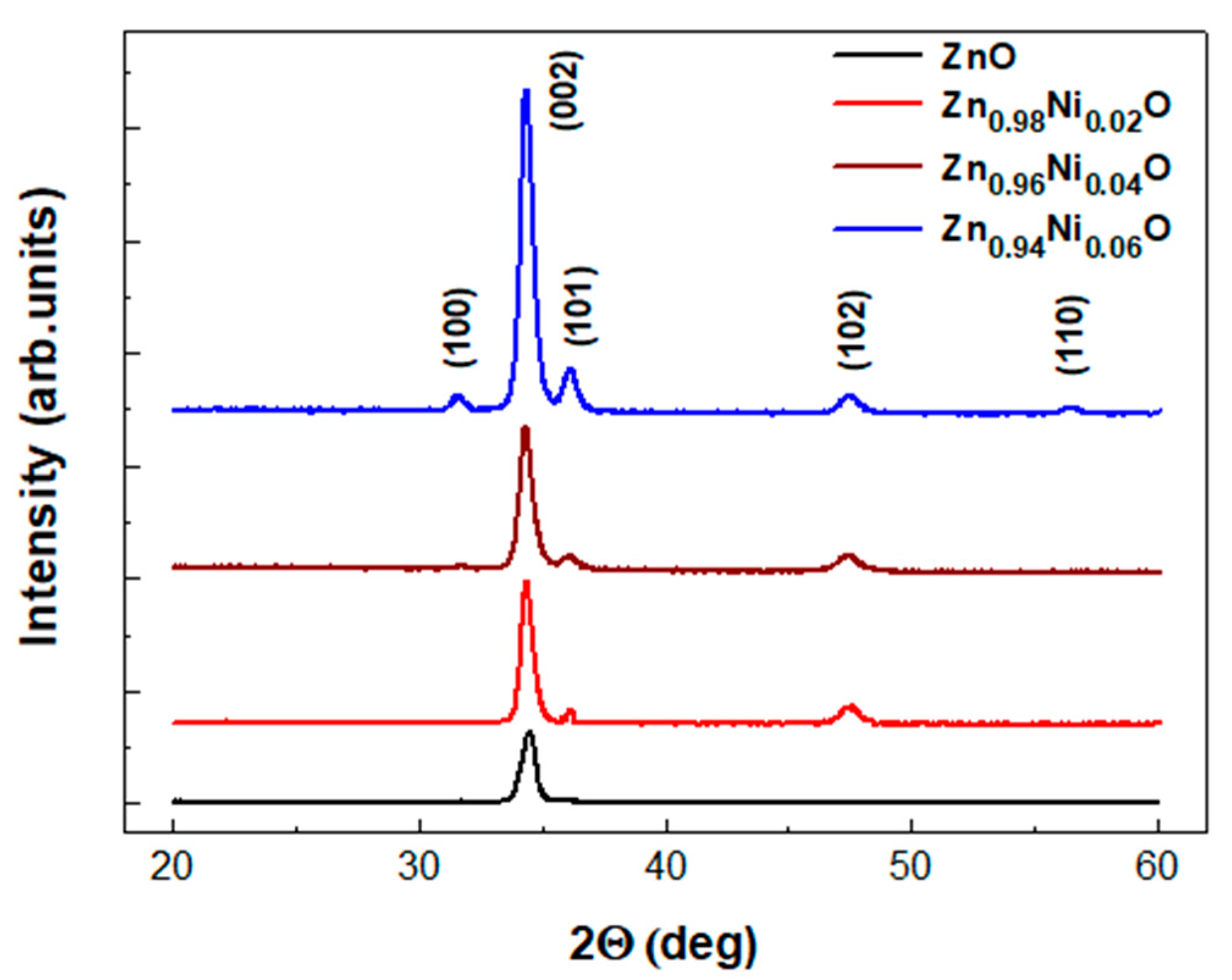
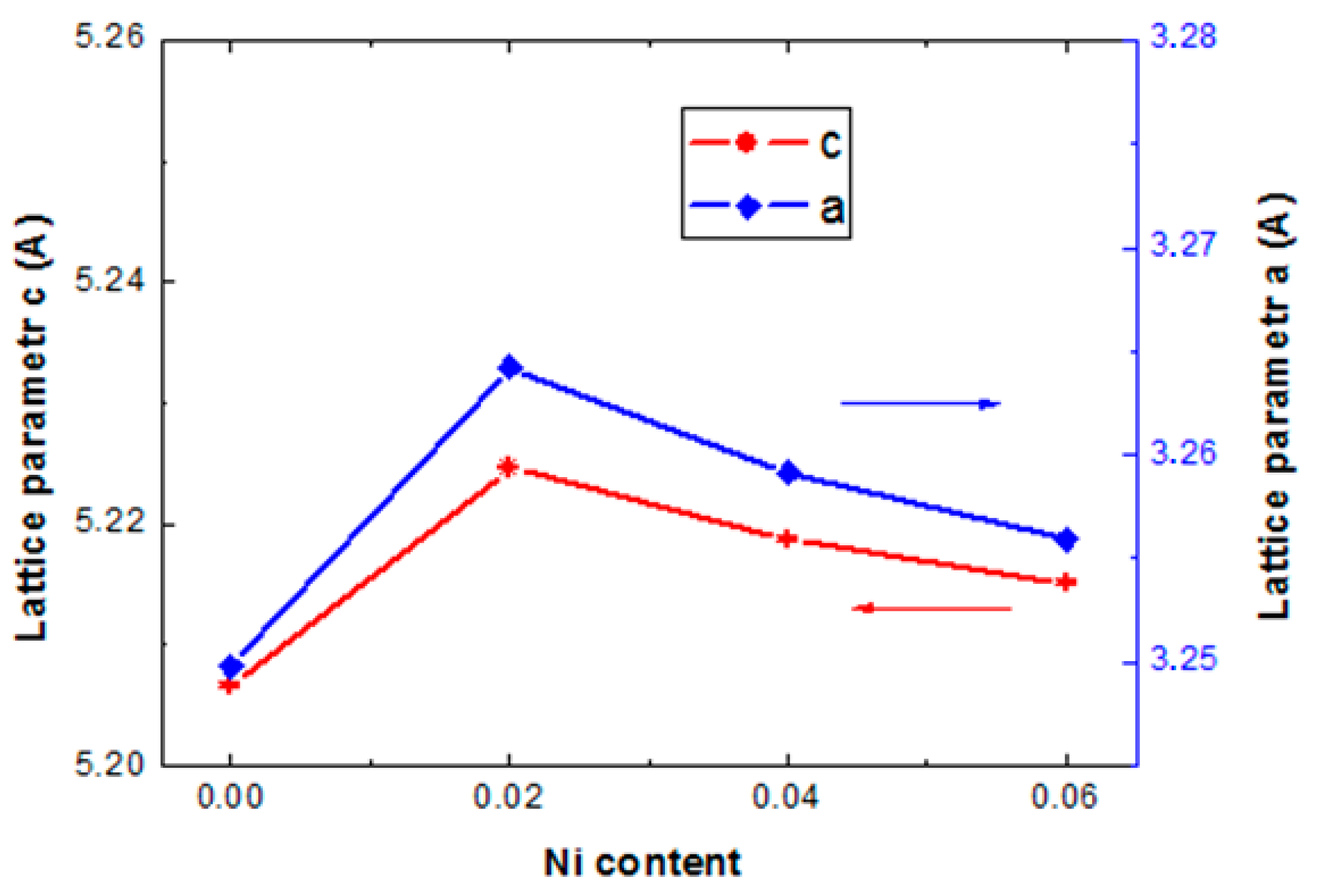
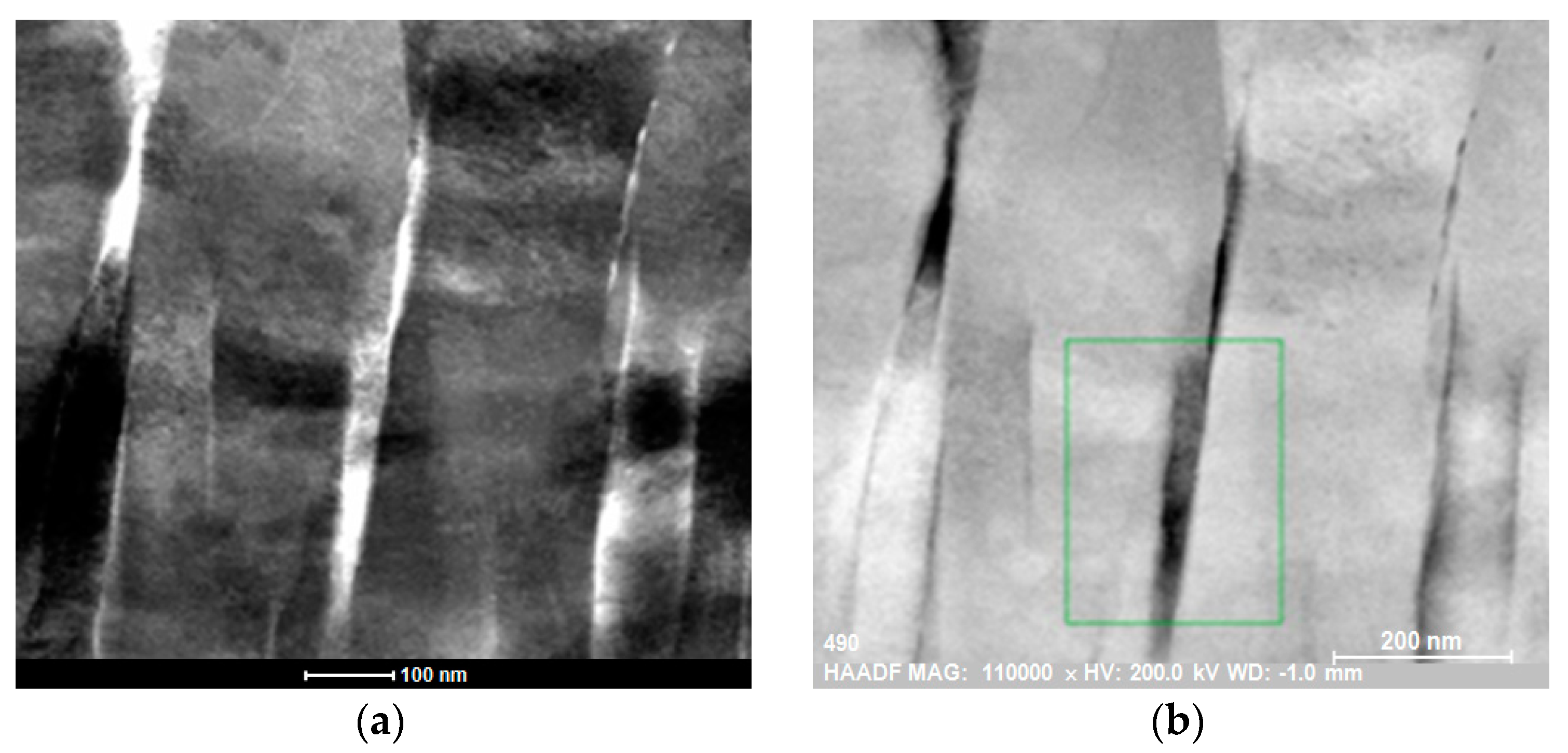
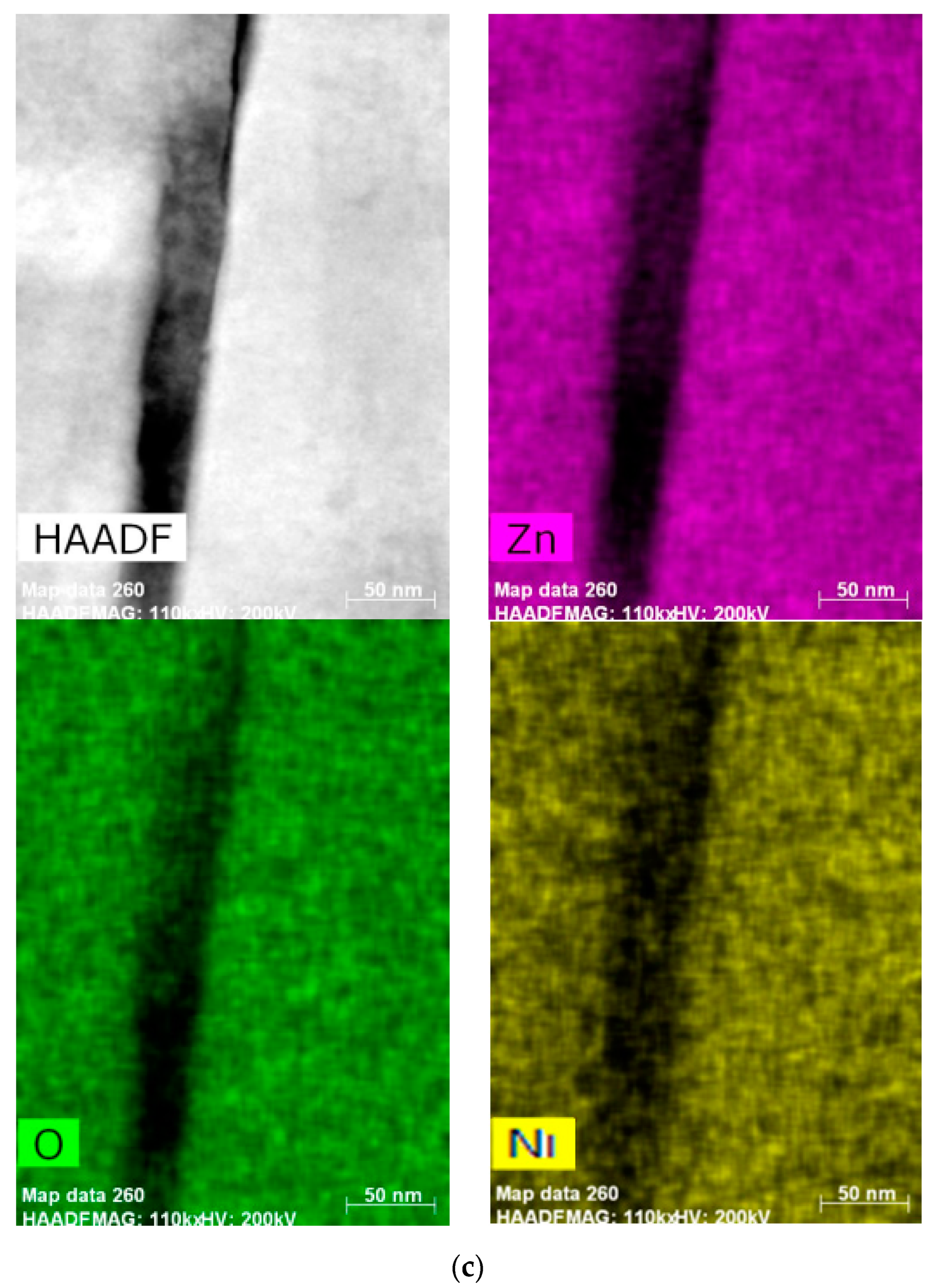
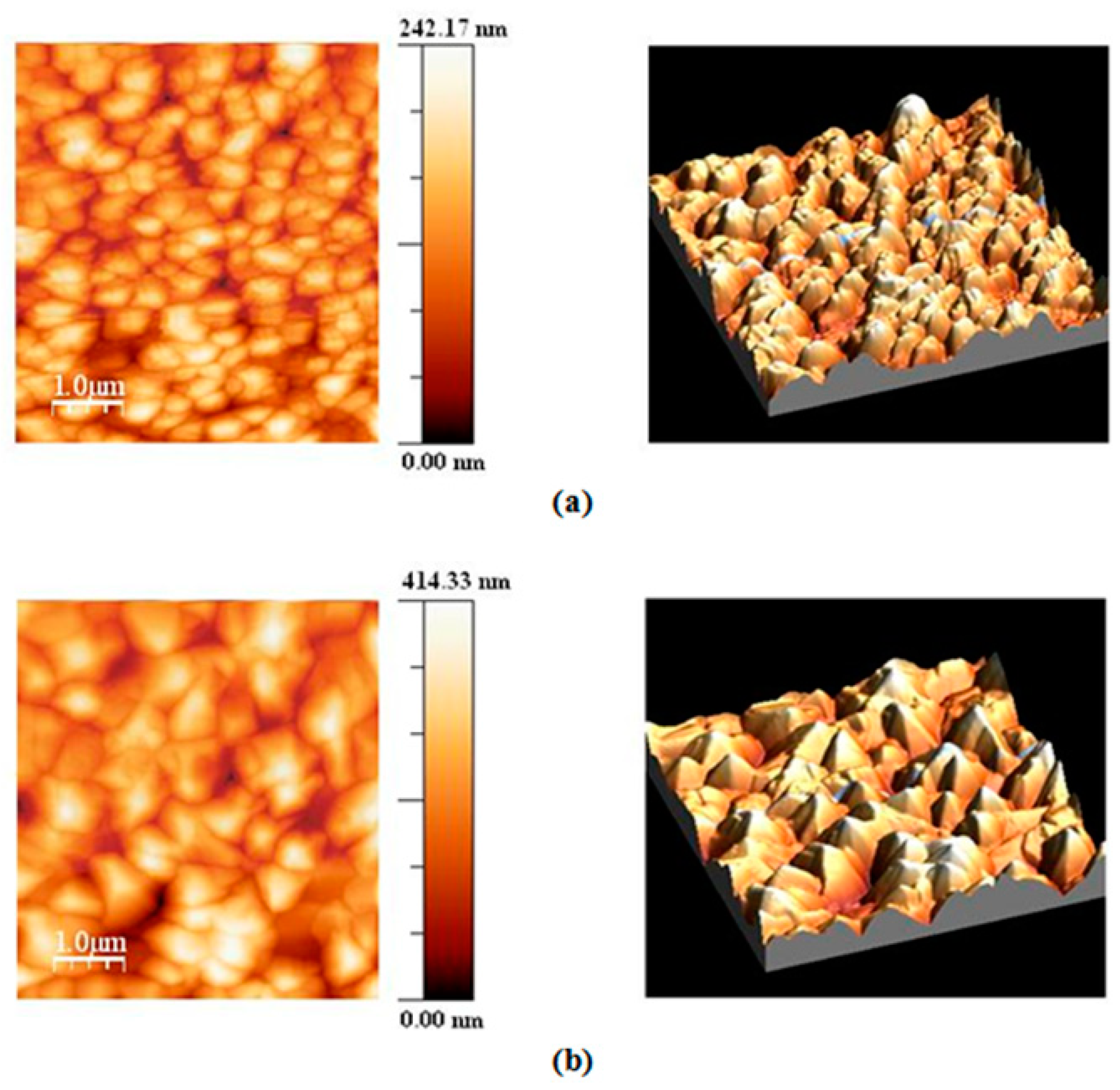

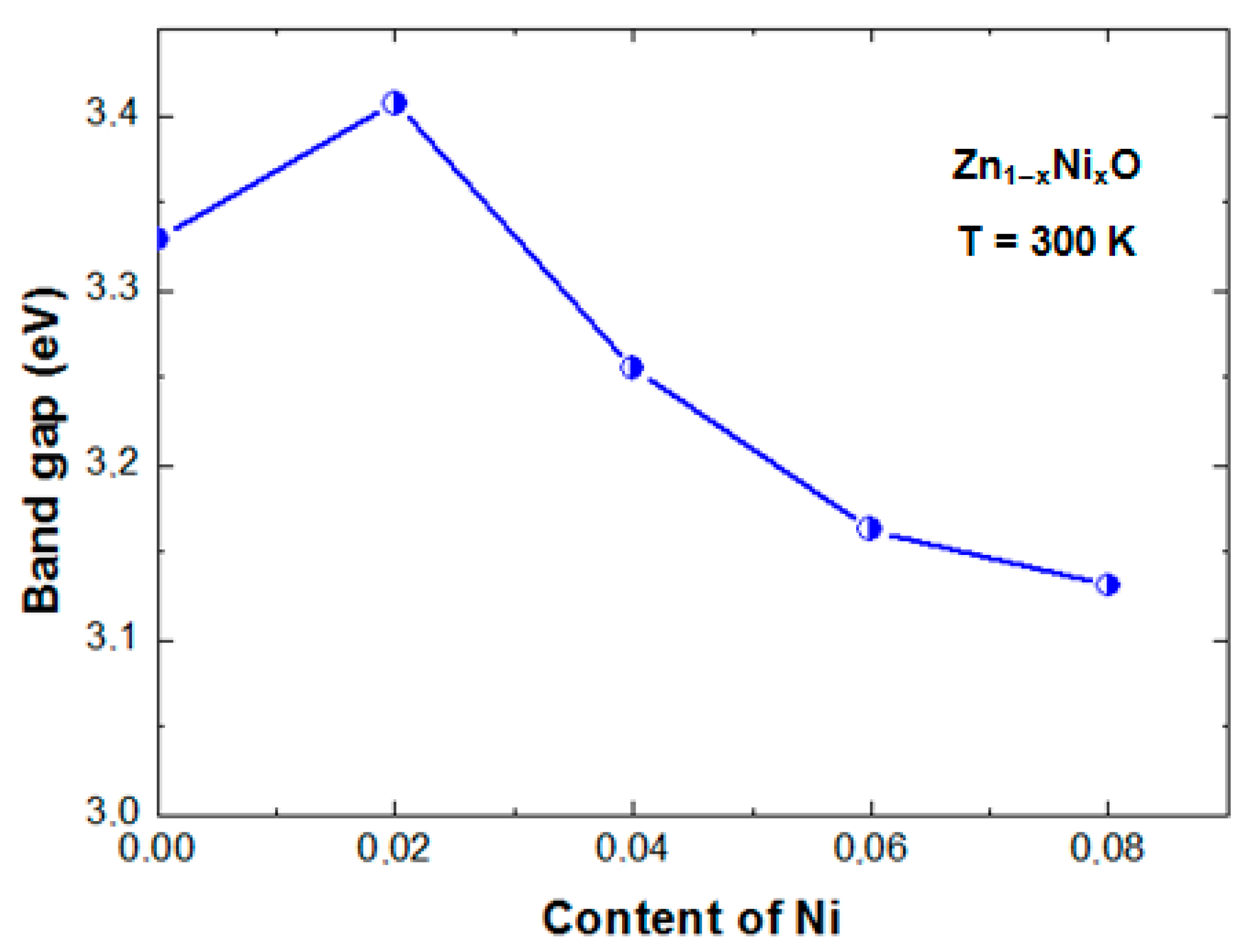
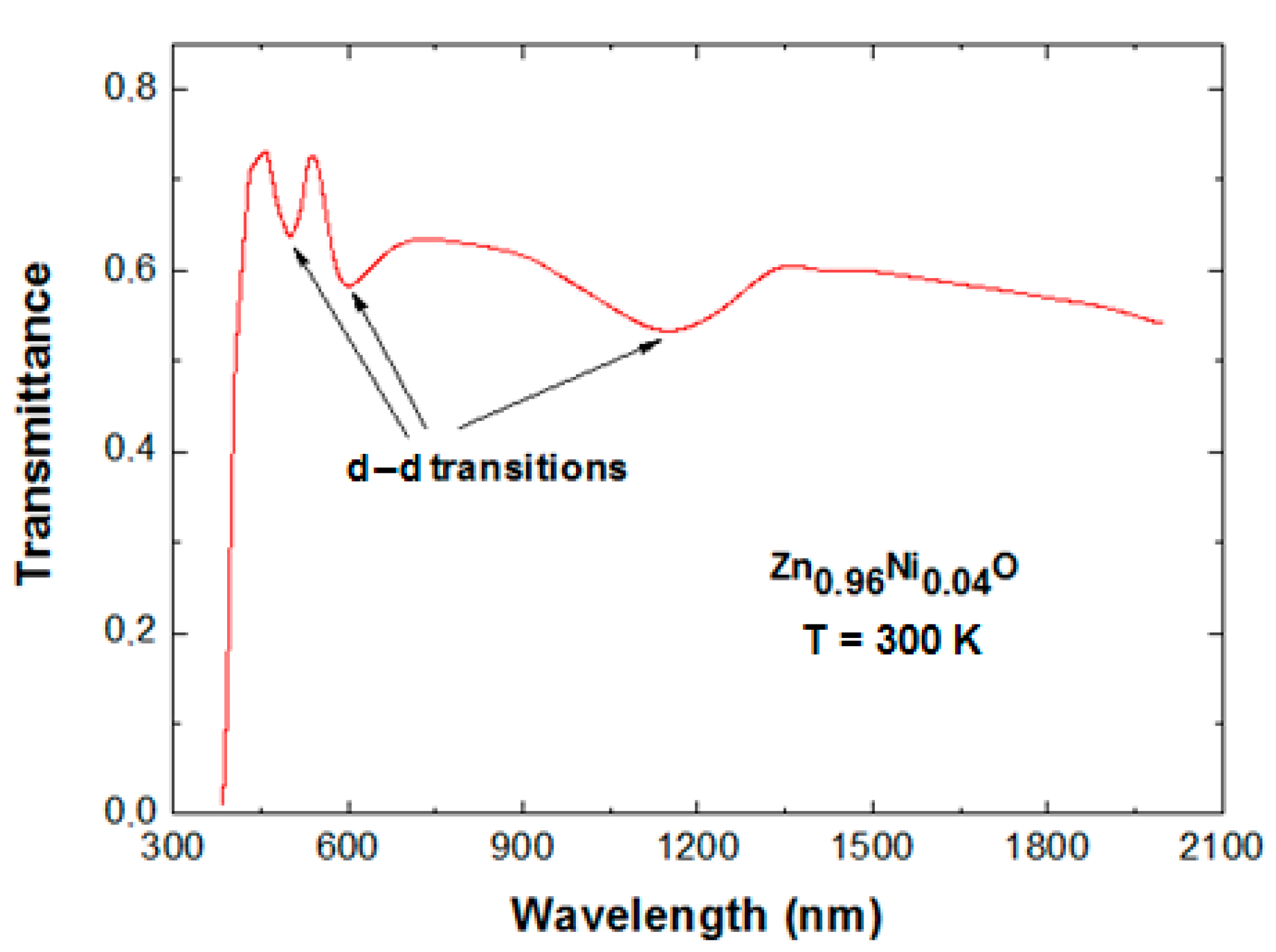
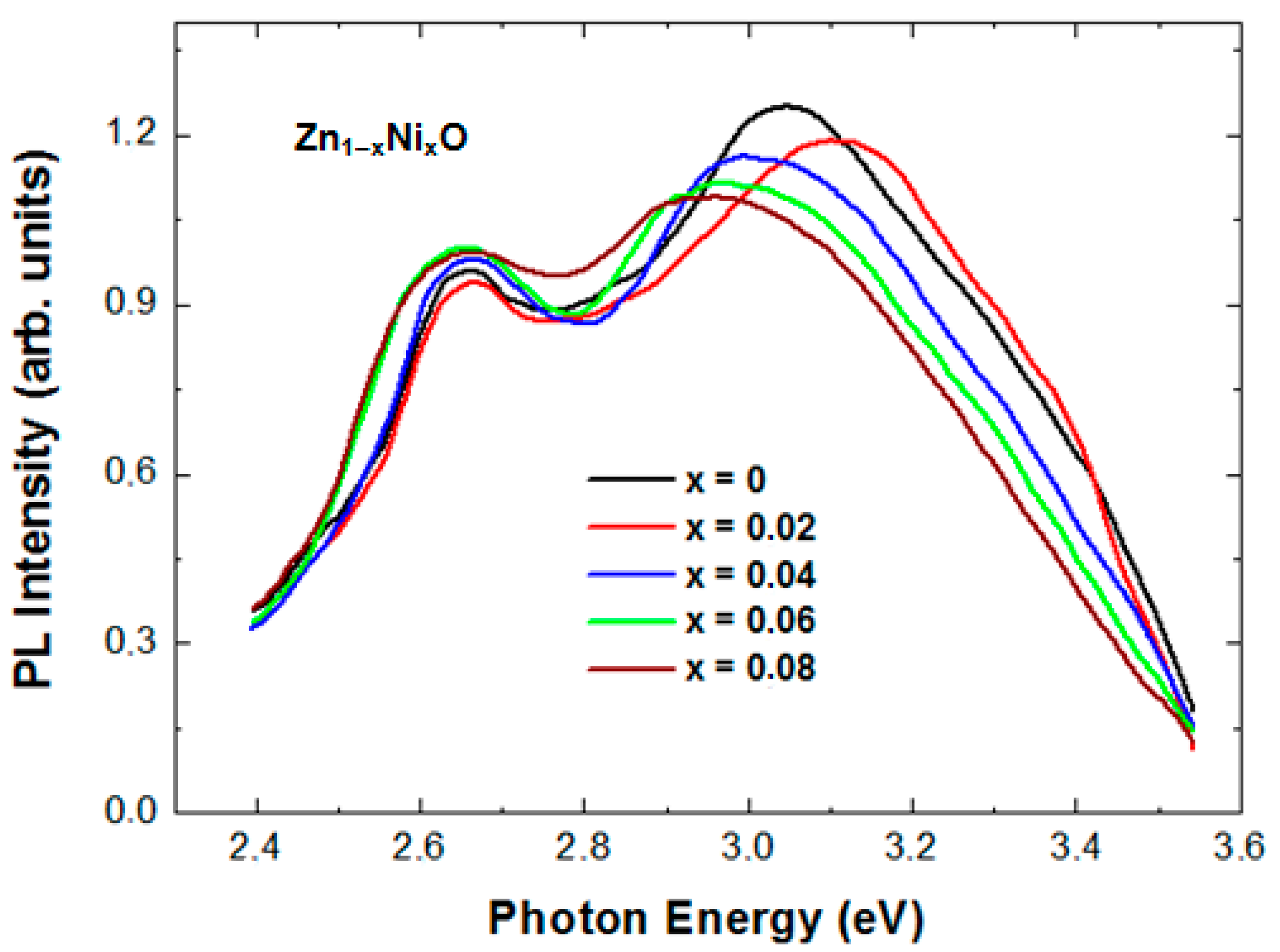
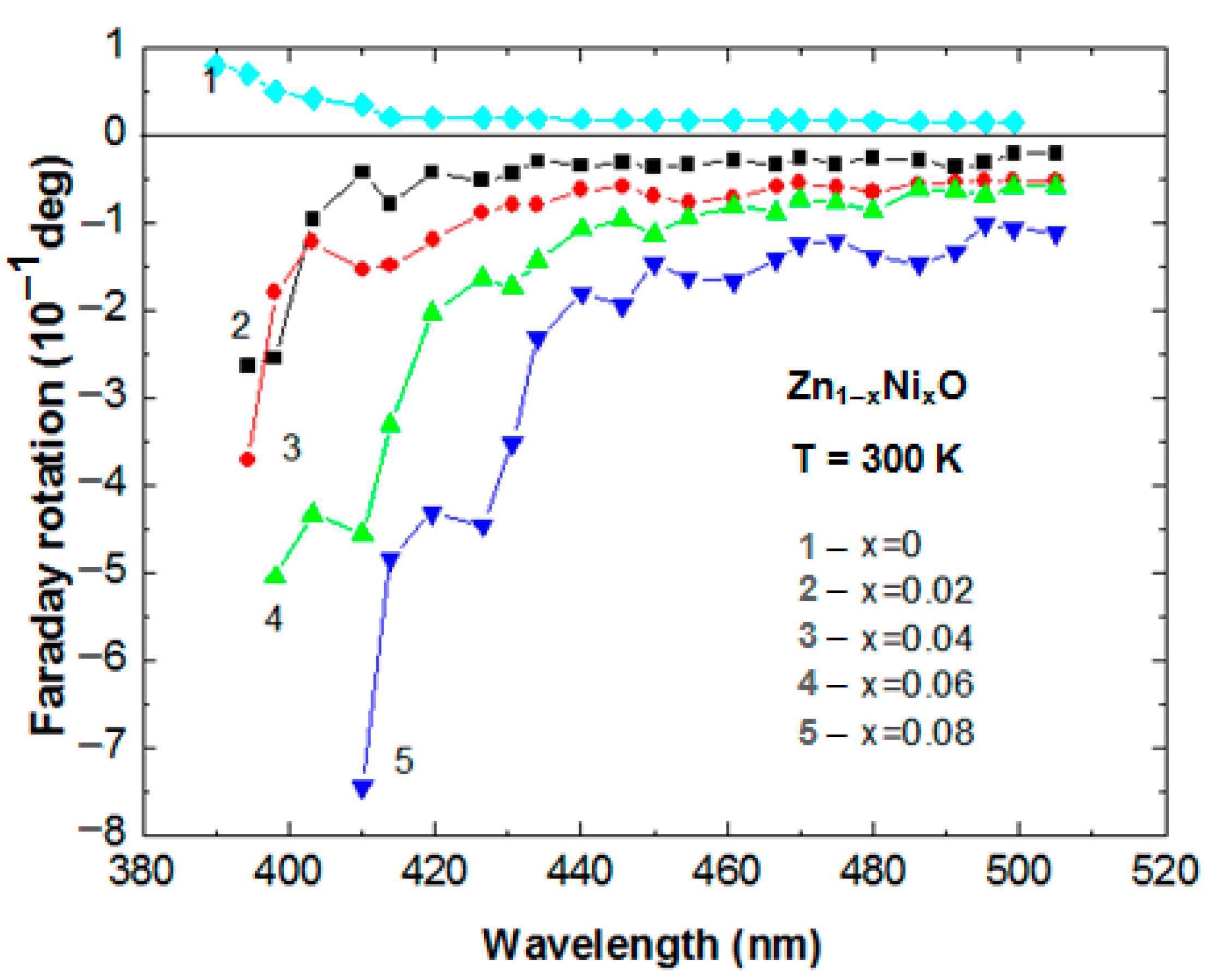
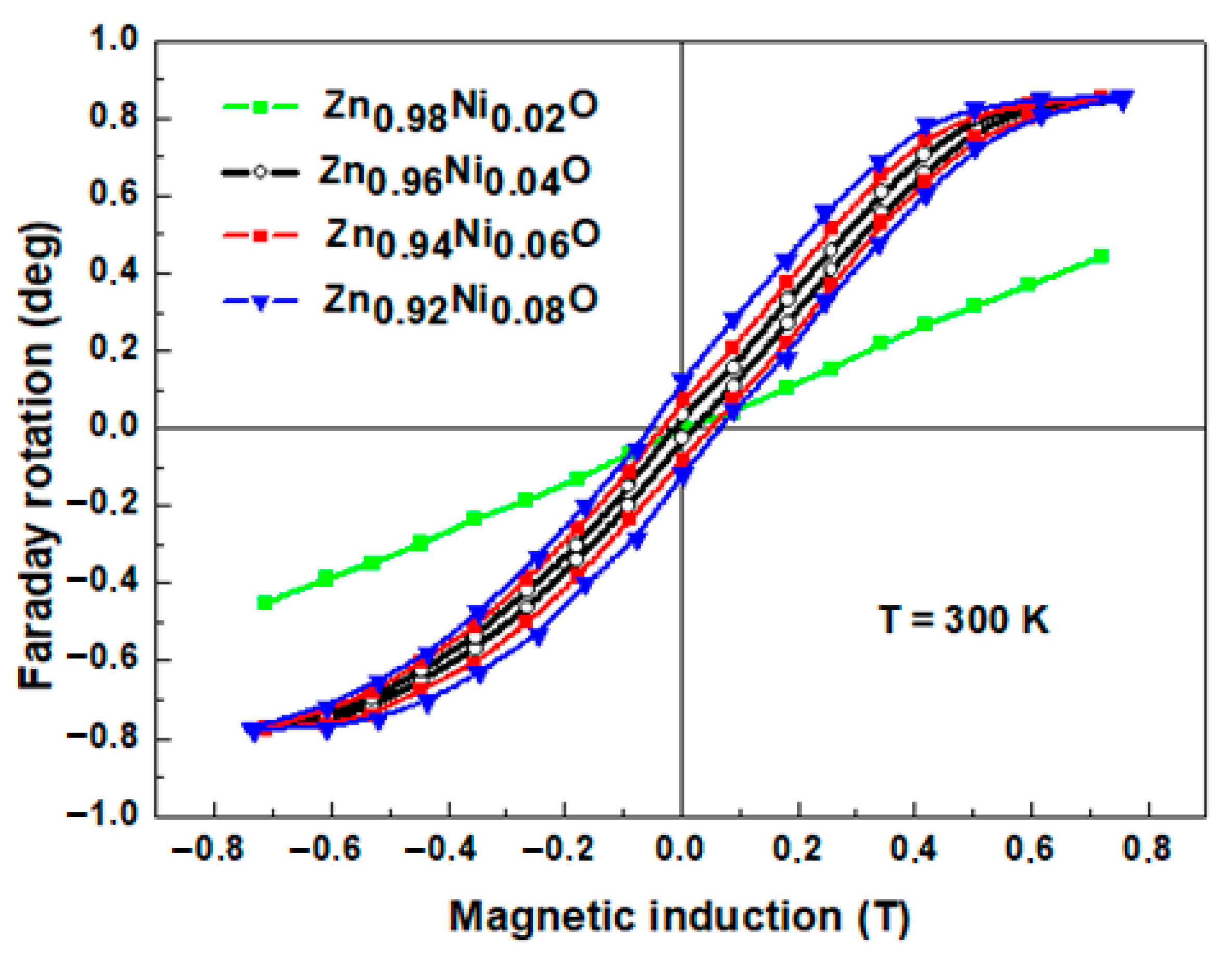
Disclaimer/Publisher’s Note: The statements, opinions and data contained in all publications are solely those of the individual author(s) and contributor(s) and not of MDPI and/or the editor(s). MDPI and/or the editor(s) disclaim responsibility for any injury to people or property resulting from any ideas, methods, instructions or products referred to in the content. |
© 2023 by the authors. Licensee MDPI, Basel, Switzerland. This article is an open access article distributed under the terms and conditions of the Creative Commons Attribution (CC BY) license (https://creativecommons.org/licenses/by/4.0/).
Share and Cite
Stolyarchuk, I.; Kuzyk, O.; Dan’kiv, O.; Dziedzic, A.; Kleto, G.; Stolyarchuk, A.; Popovych, A.; Hadzaman, I. Growth of Zn1−xNixO Thin Films and Their Structural, Optical and Magneto-Optical Properties. Coatings 2023, 13, 601. https://doi.org/10.3390/coatings13030601
Stolyarchuk I, Kuzyk O, Dan’kiv O, Dziedzic A, Kleto G, Stolyarchuk A, Popovych A, Hadzaman I. Growth of Zn1−xNixO Thin Films and Their Structural, Optical and Magneto-Optical Properties. Coatings. 2023; 13(3):601. https://doi.org/10.3390/coatings13030601
Chicago/Turabian StyleStolyarchuk, Ihor, Oleh Kuzyk, Olesya Dan’kiv, Andrzej Dziedzic, Gennadiy Kleto, Andriy Stolyarchuk, Andriy Popovych, and Ivan Hadzaman. 2023. "Growth of Zn1−xNixO Thin Films and Their Structural, Optical and Magneto-Optical Properties" Coatings 13, no. 3: 601. https://doi.org/10.3390/coatings13030601
APA StyleStolyarchuk, I., Kuzyk, O., Dan’kiv, O., Dziedzic, A., Kleto, G., Stolyarchuk, A., Popovych, A., & Hadzaman, I. (2023). Growth of Zn1−xNixO Thin Films and Their Structural, Optical and Magneto-Optical Properties. Coatings, 13(3), 601. https://doi.org/10.3390/coatings13030601






